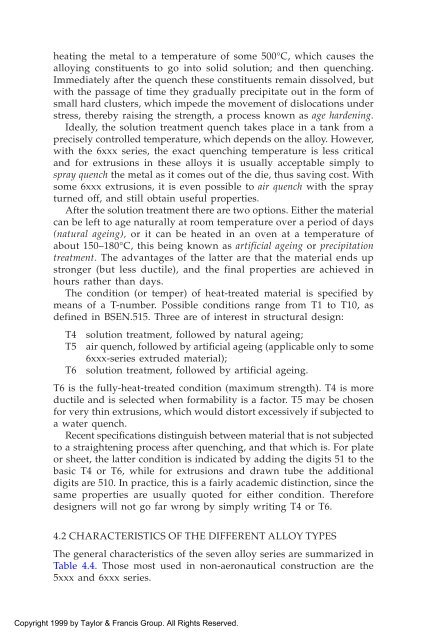Aluminium Design and Construction John Dwight
Aluminium Design and Construction John Dwight
Aluminium Design and Construction John Dwight
You also want an ePaper? Increase the reach of your titles
YUMPU automatically turns print PDFs into web optimized ePapers that Google loves.
heating the metal to a temperature of some 500°C, which causes the<br />
alloying constituents to go into solid solution; <strong>and</strong> then quenching.<br />
Immediately after the quench these constituents remain dissolved, but<br />
with the passage of time they gradually precipitate out in the form of<br />
small hard clusters, which impede the movement of dislocations under<br />
stress, thereby raising the strength, a process known as age hardening.<br />
Ideally, the solution treatment quench takes place in a tank from a<br />
precisely controlled temperature, which depends on the alloy. However,<br />
with the 6xxx series, the exact quenching temperature is less critical<br />
<strong>and</strong> for extrusions in these alloys it is usually acceptable simply to<br />
spray quench the metal as it comes out of the die, thus saving cost. With<br />
some 6xxx extrusions, it is even possible to air quench with the spray<br />
turned off, <strong>and</strong> still obtain useful properties.<br />
After the solution treatment there are two options. Either the material<br />
can be left to age naturally at room temperature over a period of days<br />
(natural ageing), or it can be heated in an oven at a temperature of<br />
about 150–180°C, this being known as artificial ageing or precipitation<br />
treatment. The advantages of the latter are that the material ends up<br />
stronger (but less ductile), <strong>and</strong> the final properties are achieved in<br />
hours rather than days.<br />
The condition (or temper) of heat-treated material is specified by<br />
means of a T-number. Possible conditions range from T1 to T10, as<br />
defined in BSEN.515. Three are of interest in structural design:<br />
T4 solution treatment, followed by natural ageing;<br />
T5 air quench, followed by artificial ageing (applicable only to some<br />
6xxx-series extruded material);<br />
T6 solution treatment, followed by artificial ageing.<br />
T6 is the fully-heat-treated condition (maximum strength). T4 is more<br />
ductile <strong>and</strong> is selected when formability is a factor. T5 may be chosen<br />
for very thin extrusions, which would distort excessively if subjected to<br />
a water quench.<br />
Recent specifications distinguish between material that is not subjected<br />
to a straightening process after quenching, <strong>and</strong> that which is. For plate<br />
or sheet, the latter condition is indicated by adding the digits 51 to the<br />
basic T4 or T6, while for extrusions <strong>and</strong> drawn tube the additional<br />
digits are 510. In practice, this is a fairly academic distinction, since the<br />
same properties are usually quoted for either condition. Therefore<br />
designers will not go far wrong by simply writing T4 or T6.<br />
4.2 CHARACTERISTICS OF THE DIFFERENT ALLOY TYPES<br />
The general characteristics of the seven alloy series are summarized in<br />
Table 4.4. Those most used in non-aeronautical construction are the<br />
5xxx <strong>and</strong> 6xxx series.<br />
Copyright 1999 by Taylor & Francis Group. All Rights Reserved.















